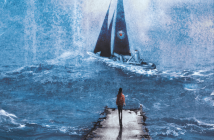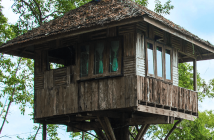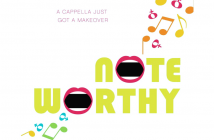 Backlist Bonanza offers a look at books published more than two years ago that are worth a read or a re-read!
Backlist Bonanza offers a look at books published more than two years ago that are worth a read or a re-read!
Justin Woolley joins us today to talk about his Territory series, a post-apocalyptic trilogy set in the Australian outback hundreds of years after the fall of civilization where the last of mankind, stranded in the desert, is kept safe by a large border fence.
Until the fence falls.
In the first book, A Town Called Dust (2015), Squid is a young orphan living under the oppressive rule of his uncle in the outskirts of the Territory. Lynn is a headstrong girl with an influential father who has spent her entire life within the walled city of Alice. When the border fence is breached, the Territory is invaded by the largest horde of undead ghouls seen in two hundred years. Squid is soon conscripted into the Diggers, the armed forces of the Territory, and after Lynn finds herself at odds with the Territory’s powerful church, she too escapes to join the Diggers. Together Squid and Lynn form an unlikely friendship as they march to battle against the ghouls and discover secrets about themselves, their world, and a conspiracy that may spell the end of the Territory as they know it.
A Town Called Dust and its sequels, A City Called Smoke (2015) and A World of Ash (2016), are all available now.
Your trilogy features a vivid post-apocalyptic world, including windswept desert landscapes, a massive border fence, hordes of undead ghouls, glass-floored dirigibles, horse-driven plows, steamcycles, and bio-trucks. How did you go about building the world of the Territory? What inspired the landscape and technology of this world?
The inspiration for the world of the Territory came from the Central Australian outback. I spent some time out there and was blown away by the vastness of it. There are places where you can pull over on the side of the road, step out of the car and there is nothing but the flat, seemingly unending desert in all directions without another person in sight. It makes you feel extraordinarily small.
That experience was the initial seed for wanting to write a book set out there and that landscape just immediately lends itself to post-apocalyptic and dystopian stories because it already feels apocalyptic in a lot of ways, as if the world has ended and humanity is left to scratch what existence it can from a scorched earth—just look at the Mad Max films as the perfect example of that. The other aspects of the world all grew out from that. The idea behind the ghouls came about because I have always been interested in using the zombie-type monster in a book. I think the idea of the horde is an excellent one for creating tension. The fact that one zombie might not be that dangerous but when there are hundreds upon hundreds bearing down on you is an excellent metaphor for feeling overwhelmed and facing great odds. However, I wanted to do something different with the monsters in the book and so I took further inspiration from the environment where the book is set. The ghouls are constantly drying out and become desiccated like the desert around them and so instead of hunting brains, they search out the moisture in living things.
Much of the technology was based on extrapolating—with some creative license—the type of technologies that humans might be able to maintain in the areas in and around Alice Springs.
How does it feel to look back on stories you wrote years ago? Has your perspective on these books evolved with time?
Looking back on the Territory series is somewhat bittersweet. I still really enjoy the world I created and the story I forged
ithin that world—plus it was my first published book so that’s always special—but I’m also victim to what I suppose is the curse of all creatives in that you are constantly improving which means you always feel like you’re better than the work you’ve finished. My perspective on the Territory series now is that I would do SO MANY things differently but I’m also accepting that that will be the case with every book I write!
How have readers responded to the Territory series? Does the response of readers impact you as a writer?
Readers have responded really well to the series. Reviews have been positive and I’ve received a lot of great feedback particularly about the world-building and the Australian setting from both Australian and international readers. The response of readers absolutely impacts me as a writer—it’s probably the best part! I really enjoy hearing from readers whether that’s over social media, via email, or face to face during conventions or book events. I think meeting readers at events like that is my favourite thing. It’s wonderful to have people come up and talk about the book and what they liked (or didn’t like) about it. It makes me realise that this crazy world and the characters within it have leaped out of my head and into someone else’s. Writing is a solo activity but hearing from readers is what reminds me that, at the end of the day, a story is really a partnership between writer and reader.
You note that, “by nature of its setting in the Australian outback,” this series includes indigenous characters and “some commentary on the continuing oppression of indigenous characters by the broader community even hundreds of years from now.” Could you talk more about how the setting played a role in the creation of your characters and the institutions, privileges, and prejudices that make up their social hierarchy? How did the history of Australia influence your post-apocalyptic vision of its future?
Australian history, as with many parts of the world, is scarred by the mistreatment of its indigenous population through colonialism. This oppression has led to issues that are still very prevalent in the country today in the wealth, health, and education gap between indigenous Australians and the rest of the Australian population. I am not an indigenous Australian (I actually have Maori ancestry) and so I didn’t want to try and tell a story about the oppression of Indigenous Australians; there are people in this country whose voices should be heard to do that. However, in saying this I also didn’t want to “whitewash” Indigenous culture out of the book. In setting a story in the Australian outback I wanted to ensure there was representation of the culture that has lived on that land for 40,000 years. There are characters in the series, particularly in the second and third books, who are Indigenous Australians. Throughout the series I try and explore, without being too heavy-handed, the fact that even in a post-apocalyptic future there is still oppression and prejudice. For example the nomadic population who maintain close ties to the land in the way of Indigenous Australians are pushed into the outer regions of the Territory and are looked down on by those wealthy people who live in the city of Alice or the larger towns. Uluru, an incredibly sacred site to the Indigenous people, has been used as a fortress and staging ground for the army in its battle against the ghouls. This was a deliberate choice I made to reflect the way that people dismiss the concerns of oppressed cultures. I hope I’ve managed to explore some of these themes while being respectful of Indigenous culture and at the same time telling what is still ultimately a fictional tale about a post-apocalyptic world hundreds of years from now.
Has your approach to writing changed since these books? If so, in what ways? If not, what has stayed the same?
My approach to writing has changed in that I don’t do as much explicit planning now. I certainly wouldn’t say I’ve gone from a plotter to a pantser but I think it’s natural to internalise a lot of the thinking that’s done in writing as you gain experience. I still plan out my books prior to beginning the first draft but I certainly don’t do it in anywhere near as much detail as I did with A Town Called Dust, A City Called Smoke, and A World of Ash. I still take much the same approach in terms of my actual writing process. I write the book sequentially from beginning to end trying not to go back at all during my first draft and then I put it aside for a few weeks before returning to it to begin the editing and rewriting process.
What have you worked on since these books? Can you share any details about your current project(s)?
I’ve been working on a bunch of things since the end of the Territory series. Firstly, I’m excited to say that the Territory series has been optioned for development as a television series so I’ve been working with a director on trying to get that off the ground. I’ve finished two other YA novels. One is a science fiction alien invasion story full of hacking, telekinetic powers, and giant alien crabs out to mind-control the planet. I’m trying to find a home for that at the moment. The other is a YA fantasy that’s a little like Six of Crows meets The Departed, I’m working through what is probably the last draft of that book. I’m also writing an adult science fiction comedy at the moment that’s basically about what happens when a starship captain who graduated bottom of the academy is given command of the galaxy’s most advanced starship and becomes the last chance against the extinction of all sentient life—no pressure there. So I like to keep busy!
Do you have any advice for new writers on the twists and turns that a career in publishing can take?
One thing that’s become very obvious to me is that there’s no one pathway to success and that things rarely go the way you expect. When I first had A Town Called Dust picked up for publication by a Big 5 publisher I figured that once I had one book published it may not be a huge bestseller but that it would be easy (or easier at least) to get more books published. Unfortunately, the imprint I was published by closed down and consequently a lot of the connections I had were lost too. I have an agent but I’m sorry to say that finding a brand new publisher with a new series even once you’re no longer a debut author can still be challenging!
Who do you hope will find this series?
It’s interesting because while I wrote this book for a YA audience it has mostly been read by adults. Now, don’t get me wrong, I have no issue with adults reading YA (I do!) and I’m absolutely thankful to those who have, but I’d love for more young readers to find the book. Particularly I’d love to see younger boys reading it because I know how reluctant they can be to read and I’d be thrilled if my book could help get more teen boys into reading!
What else would you like readers to know about the Territory series?
I’d just like to assure readers outside of Australia that there aren’t really moisture-sucking monsters roaming the country ready to kill you with one bite—there’s just snakes and spiders and crocodiles and sharks for that.




